How Often to Replace Roof. Expert Tips
Roof Materials and the Local Climate determine how often you will need to replace the Roof.
HOME / HOW OFTEN TO REPLACE ROOF
Deciphering the Lifespan of Your Roof: A New Jersey Homeowner's Guide
Understanding the lifespan of your roof is crucial for homeowners in New Jersey (NJ) and Pennsylvania (PA). With varying weather conditions and material choices, knowing when to replace your roof can save you time, money, and potential hazards. Dive into our comprehensive guide to make informed decisions.
Climate and weather conditions are important factors in determining a roof’s lifespan, especially in popular roofing materials like tile and metal. Hiring a reliable roofing company is crucial in ensuring the longevity of your roof. Regular inspections are essential for homeowners to assess the condition of their roofs, whether they have tile roofing, asphalt shingles, or any other type, and determine if repair or replacement is necessary.
Hiring a reputable roofing company for these inspections and any necessary repairs is important. In this region, metal roofing is one of the most popular roofing materials, typically lasting between 20 to 30 years. However, extreme temperatures, heavy rainfall, or high winds can accelerate wear and tear, leading to wood rot in the ceiling. Our professional roofing contractor team will accurately evaluate the condition of a roof, identify issues such as wood rot and flashing problems, and provide recommendations for replacement or upkeep when needed. With their knowledge and experience, they can handle a variety of roofing concerns.
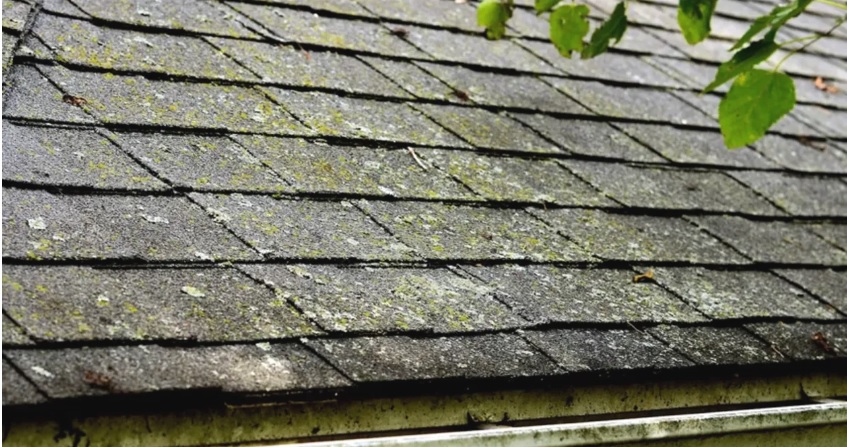
Roof replacement in New Jersey after the storm.
Call Today: (609) 516-8946
Get your FREE roof Consult
Understanding how often a roofing material should be replaced is crucial for homeowners to ensure the safety and integrity of their homes. Regular upkeep is necessary to prevent wood rot and identify the need for replacement. By considering climate conditions, conducting regular inspections, and consulting with professionals in the field, homeowners can make informed decisions about roof replacements that align with their needs.
Factors That Determine How Often You Should Replace Your Roof
The frequency at which a roof must be replaced depends on several factors:
- Age and Wear and Tear: The older the roof, the more likely it is to require replacement. Over time, exposure to UV rays and weather elements can cause wear and tear, compromising durability.
- Storm Damage: Harsh weather conditions such as hailstorms or hurricanes can significantly damage roofs. Immediate replacement may be necessary to ensure the safety and integrity of the structure.
- Poor Installation or Maintenance: Improper maintenance can lead to premature roof deterioration. If not addressed promptly, it can shorten the lifespan of any roofing system and necessitate early replacement.
- Energy Efficiency and Roofing Costs: As advancements in energy-efficient roofing materials continue, homeowners may opt for replacements earlier than expected to save on roofing costs in the long run.
Considering these factors will help determine when it is time for a roof replacement. Regular inspections by professionals are essential in identifying signs of aging or damage to a cedar shake roof that may require attention. By addressing these issues proactively, homeowners can extend the life of their roofs while ensuring their homes’ safety and protection.
Remember that consulting with a roofing contractor that provides a range of roofing services is crucial for accurate assessments and recommendations tailored to your situation.
Moisture and Water Stains: Identifying Potential Roof Damage
Water stains on ceilings, mold growth, discoloration or peeling paint, and sagging or soft spots on the roof are all signs that your roof may be damaged. By paying attention to these indicators, you can identify potential issues before they escalate.
Water stains on ceilings: If you notice water stains on your ceiling, it could indicate a roof leak. These stains often appear as discolored patches or rings and should not be ignored. They suggest moisture penetrates through the roof and seeps into your home.
Mold growth: Mold is another indication of moisture penetration through the roof. Mold thrives in damp environments, so it’s important to address the issue promptly if you spot mold growth in your attic or upper walls. Mold not only damages your home but also poses health risks.
Discoloration or peeling paint: When water enters your home due to a damaged roof, it can cause paint to discolor or peel off walls and ceilings. This is often a clear sign that water damage has occurred. If left unaddressed, it can lead to further deterioration of your property.
Sagging or soft spots on the roof: Structural issues with your roof can manifest as sagging or soft spots. These areas may feel weak when walked upon and require immediate attention from a professional roofer. Ignoring such problems could result in more severe damage over time.
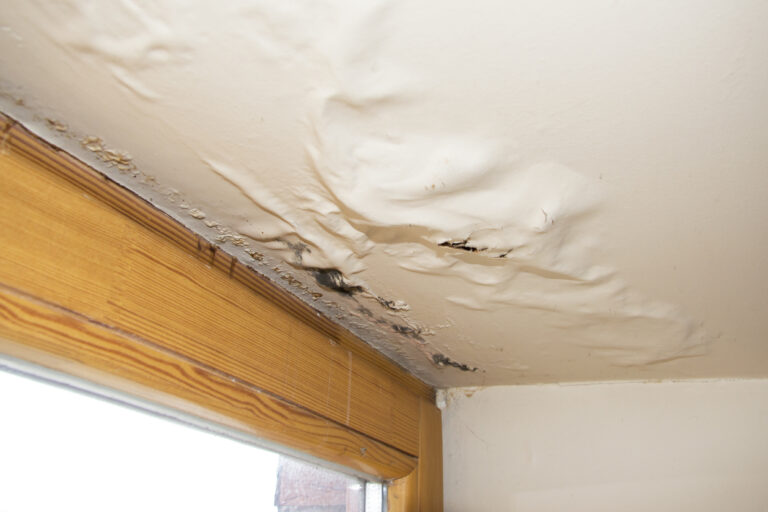
Regular roof inspections are crucial for identifying potential damage caused by moisture and other factors such as UV rays. By addressing these issues promptly, you can extend the lifespan of your roof while protecting your home from further harm.
Remember that proper maintenance is essential in preventing costly repairs down the line. So, watch for any signs of roof damage and take appropriate action when needed.
Mold, Mildew, and Water Damage: Warning Signs
Musty odors inside the house may indicate mold growth due to water damage.
Dark spots or streaks on walls could be signs of mildew formation.
Peeling wallpaper or bubbling paint might result from water infiltration.
Visible signs of rotting wood near the roofline suggest water damage.
Water damage can wreak havoc on your home, leading to mold growth, mildew formation, and structural deterioration. Identifying warning signs in a timely manner is crucial to prevent further damage and costly repairs. Here are some key indicators that you should be aware of:
Musty Odors: If you notice a persistent musty smell inside your house, it could be a sign of mold growth caused by water damage. Mold thrives in damp environments and often goes unnoticed until its distinct odor becomes apparent.
Dark Spots or Streaks: Keep an eye out for dark spots or streaks on your walls, as they may indicate the presence of mildew. These discolorations are typically caused by excess moisture seeping into the walls.
Peeling Wallpaper or Bubbling Paint: Water infiltration can cause wallpaper to peel or paint to bubble, disrupting the adhesive properties. If you observe these issues, there is likely an underlying leak or moisture problem that needs attention.
Visible Signs of Wood Rot: Look closely at wooden surfaces near the roofline, such as fascia boards or soffits. It strongly indicates long-term water damage if you notice rotting wood with visible cracks, light holes, or areas that appear discolored and weakened.
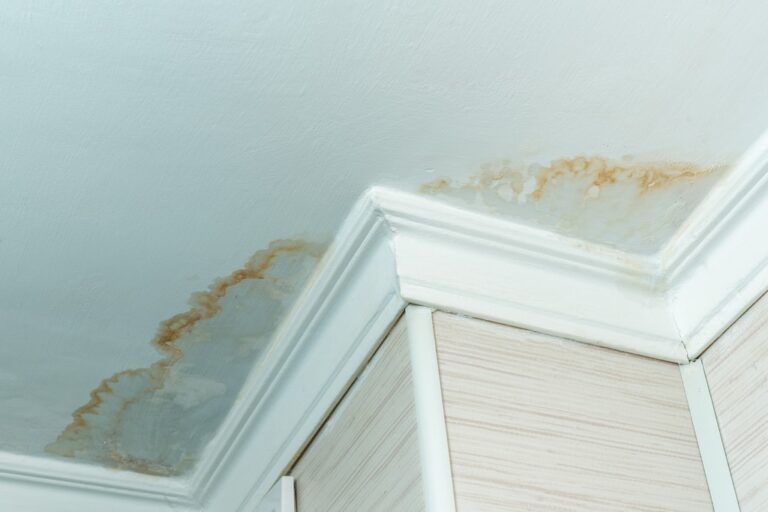
By being vigilant for these warning signs—musty odors, dark spots/streaks on walls, peeling wallpaper/bubbling paint, and visible wood rot—you can catch water damage early on and address it promptly. Regular roof inspections and proactive maintenance can help extend the lifespan of your roof and prevent costly repairs in the future.
Call Today: (609) 516-8946
Get your FREE roof Consult
Lifespan of Roofing Materials in NJ or PA: How Long Do They Last?
Roofing materials vary in life expectancy, with different factors influencing their durability. Here’s a breakdown of the average lifespan for various roofing materials commonly used in New Jersey (NJ) or Pennsylvania (PA):
Asphalt Shingles: The most popular choice, asphalt shingles typically last between 20 to 30 years.
Metal Roofs: With proper maintenance, metal roofs can endure for 40 to 70 years.
Wood Shakes/Shingles: Wooden roofs can have a lifespan of around 20 to 40 years if well-maintained.
Clay/Concrete Tiles: These durable options can last up to 50 years or more.
Slate Roofs: Known for their longevity, slate roofs often surpass the century mark and can endure over 100 years.
It’s crucial to note that these estimates are averages and can vary depending on factors such as climate conditions, installation quality, maintenance practices, and regular inspections. Individual manufacturers may provide specific warranties for their products.
Regular roof inspections by professionals are essential to identify any signs of damage or wear. If you notice missing shingles, leaks, or other issues before the estimated lifespan is reached, it might be necessary to consider roof repairs or roof replacement sooner.
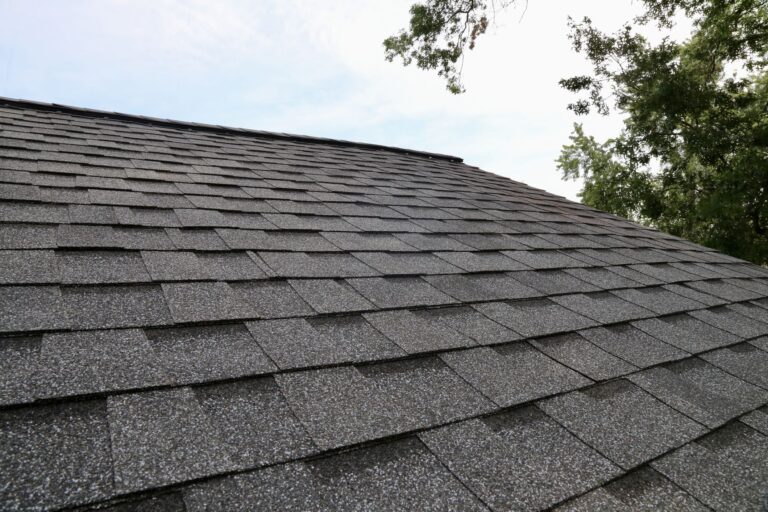
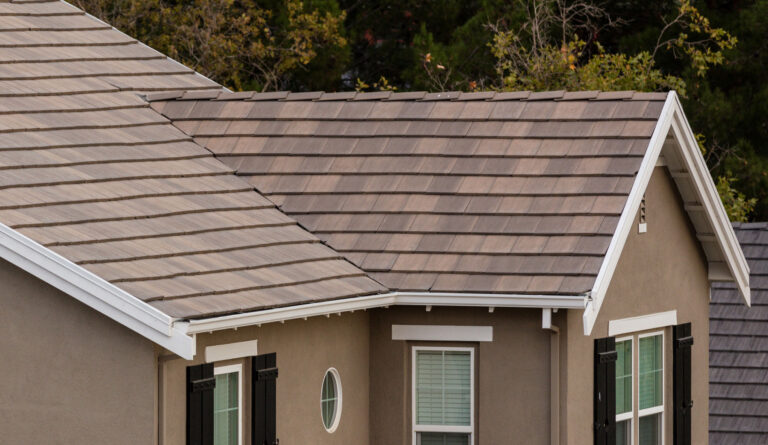
By understanding the typical lifespans of different roofing materials available in NJ or PA and ensuring proper care and maintenance, homeowners can make informed decisions about the timeliness of replacing a roof. Remember that consulting with a licensed roof replacement contractor in New Jersey is always recommended for accurate assessments and professional guidance tailored to your situation.
A regular roof inspection is essential for homeowners. By being vigilant and looking out for signs like cracked or missing shingles, water leaks or stains on your ceiling, excessive granule loss from asphalt shingles, and sagging or uneven areas, you can identify when it’s time for a roof replacement. Don’t wait until the damage worsens; take action now to avoid costly repairs in the future. Remember, a well-maintained roof protects your home and ensures the safety and comfort of you and your family. Explore different coverage options and consider their ratings when selecting a loan.
Notice any of these signs? Contact us now for a quick inspection.
LIFETIME WARRANTY
My Roofing Contractors proudly offers a 15-year warranty on all roofing labor and a 30-year warranty on all roofing materials. For a free quote, fill out the form or call us.
Comprehensive Roofing Services
Roof Replacement
Roof Repair
Seamless Gutter Solutions
- Asphalt Shingle Roofing
- Emergency Roofing Services
FREE ESTIMATES
Call Today:
(609) 516-8946
Choosing Roofing Materials for Longevity
It’s essential to consider their longevity. The right choice can save you from the hassle and expense of frequent roof replacements. Here are some popular roofing materials known for their durability:
Metal Roofing:
Metal roofs offer exceptional longevity, often lasting 40-70 years.
They are highly resistant to harsh weather conditions, including wind, rain, and snow.
Metal roofs require minimal maintenance and provide excellent energy efficiency.
Tile Roofing:
Tile roofs have a long lifespan of 50-100 years.
They are resistant to fire, insects, and rotting.
Tile roofs come in various styles and colors, adding aesthetic appeal to your home.
Wood Shake Roof:
Wood shakes have a lifespan of around 30 years when properly maintained.
They offer natural insulation properties and a unique rustic appearance.
Regular maintenance is necessary to prevent issues like moss or rot.
Composite Roofing:
Composite roofs are made from a combination of materials like asphalt or fiberglass.
They typically last around 20-30 years.
Composite shingles come in different styles, resembling wood shakes or slate tiles.
To ensure the longevity of your chosen roofing material:
Hire a reputable roofing contractor or company experienced in installing your selected material.
Ensure proper installation techniques are followed, including appropriate roof decking and underlayment.
Perform regular inspections and maintenance as recommended by the manufacturer or roofing professional.
By selecting high-quality roofing materials that suit your climate and preferences, you can enjoy a long-lasting roof that provides protection while enhancing the aesthetics of your home. Remember that each material has its advantages and considerations; therefore, assessing your needs is crucial before making a final decision.
Making Informed and Timely Decisions About Roof Replacement
Being proactive and well-informed is crucial. Regular inspections and proper maintenance play a significant role in determining how often a roof should be replaced. Here are some key factors to consider:
Inspections: Regularly inspecting your roof can help identify any issues early on. Look for signs of damage, such as missing shingles, cracked panels, or damaged flashing.
Impact of Time: A roof’s lifespan depends on various factors such as the type of material used, climate conditions, and installation quality. For example, asphalt shingle roofs typically last around 20-30 years, while cedar shake roofs may have a 30-40-year lifespan.
Proper Maintenance: Maintaining your roof through regular cleaning and repairs can extend its lifespan. Clearing debris, keeping gutters clean, and promptly addressing minor issues can prevent more significant problems.
Consulting Contractors: Consulting with professional contractors is essential for roof replacement. They can assess the condition of your roof and provide expert advice on whether repair or replacement is necessary.
Frequency: While there’s no set timeframe for replacing a roof, it’s generally recommended to replace it when signs of extensive damage or age-related wear become apparent.
By staying vigilant with inspections, addressing repairs promptly, and seeking professional guidance when needed, you can make informed decisions about when to replace your roof. Remember that each situation is unique, so it’s important to consider multiple factors before deciding on a new roof installation.
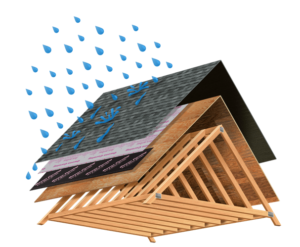
Call Today: (609) 516-8946
Get your FREE roof Consult
Considering these factors, especially cost, you can select the best roofing materials tailored to New Jersey and PA’s specific climate conditions. It’s always wise to consult a professional roofer to ensure your new roof’s proper installation and optimal performance.
Various roofing materials are available to cater to your needs, whether you’re contending with intense heat, heavy snowfall, robust winds, or fluctuating temperatures. Reflect on the weather conditions in your region and weigh the cost benefits of different materials like asphalt, metal, or even wood, provided it complies with local regulations.
Investing in the right roofing material enhances your home’s aesthetic. It offers enduring protection against issues like water leaks, ice dams, moss growth, and other challenges tied to adverse weather conditions. Moreover, considering the cost of the roofing material is pivotal in making an informed choice.
.
If Your Roof Needs Replacement: When to Take Action
We discussed the importance of identifying moisture and water stains as potential signs of roof damage and the warning signs of mold, mildew, and water damage. We delved into the lifespan of different roofing materials in NJ or PA, from slate to asphalt, and provided insights on choosing roofing materials for longevity.
It is crucial to make informed and timely decisions about roof replacement to ensure the safety and integrity of your home. Paying attention to these signs and proactively addressing any issues can prevent further damage and save money in the long run. If you notice any of these warning signs or if your roof has surpassed its expected lifespan, it may be time to consult a professional roofing contractor for an inspection and discuss potential replacement options.
FAQs
Regular inspections are recommended at least twice a year – once in spring after winter weather conditions have passed and again in fall before harsh weather sets in. However, it’s also advisable to inspect your roof after severe storms or if you suspect there may be damage.
The average lifespan of a roof is between 25 and 50 years. However, the life expectancy of a roof depends on the quality, durability, and type of material used. For example, a roof of composition shingles may need to be replaced every 12-20 years, while a metal roof may last 50-75 years.
You should start budgeting for a roof replacement around the 22-year mark. However, you may need to replace your roof sooner if a storm damages ror fails prematurely.
Roof damage can occur due to age-related wear and tear, severe weather conditions like storms or hail, improper installation, lack of maintenance, and even pest infestations. Regular inspections and timely repairs can help prevent extensive damage.
Replacing your roof can offer several benefits, such as enhanced safety and protection for your home, improved energy efficiency, increased property value, and a fresh aesthetic appearance. Knowing you have a reliable and durable structure overhead, a new roof can provide peace of mind.
- Water damage in the attic or upstairs
The roof sags
Moss, mold, or fungi have taken over
Curling or buckling shingles
Missing shingles or granules
Missing flashing, gutter guards, or fascia
Serving Central New Jersey and Easter Pensylvania
My Roofing Contractor proudly serves New Jersey and Pensylvania, specializing in high-quality roofing services. Our comprehensive roofing services encompass roof replacements, installations, and roof repairs. Reach out to us today for a complimentary quote, and let us elevate your home’s roofing standards! With our availability, we are here to serve you.